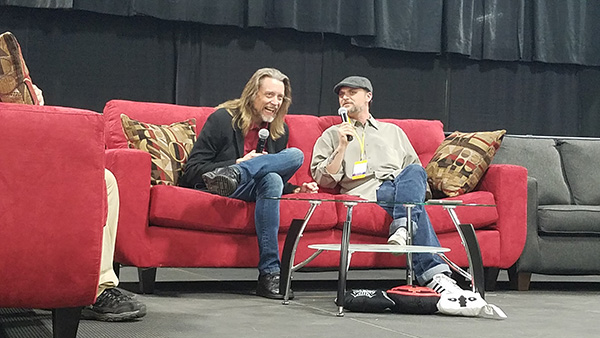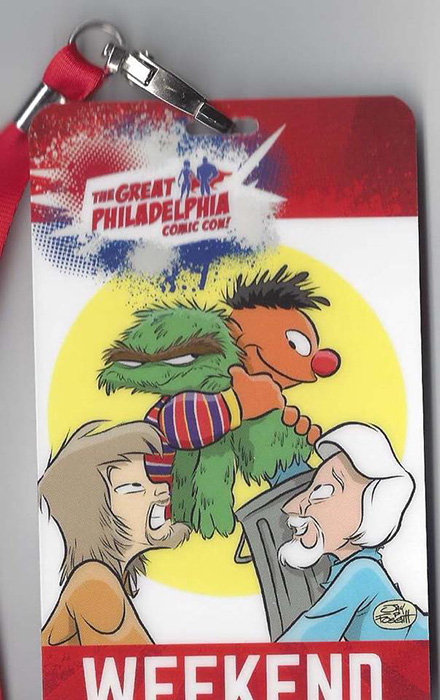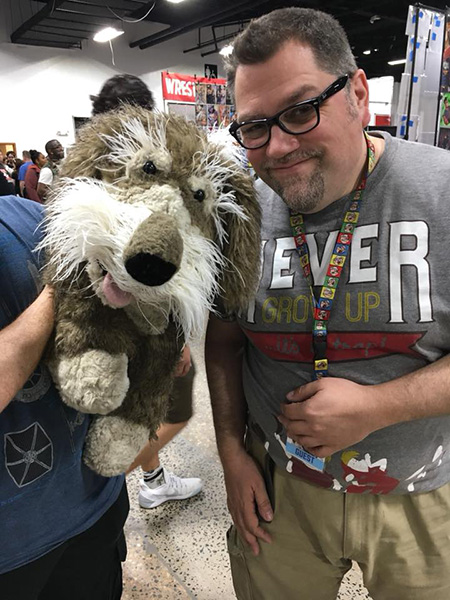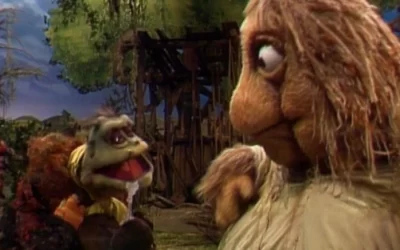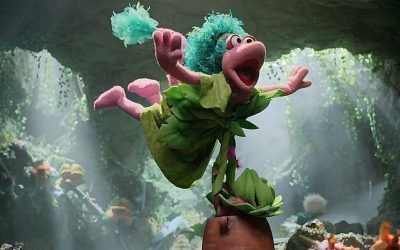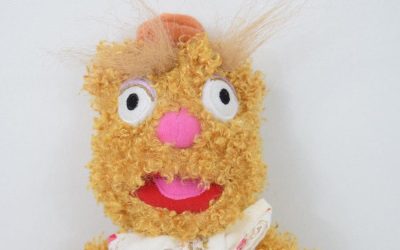Many thanks to our pal Justin Piatt for attending and reporting on this event! For more from Justin, be sure to check out his artwork here on ToughPigs, and follow him on Instagram.
Also, be sure to scroll down to watch the full video from this event!
On April 27, 28, 29, Steve Whitmire and Caroll Spinney were among the many celebrity guests at the 2018 Great Philadelphia Comic Con. A panel on Saturday called “Memory Lane to Sesame Street” was meant to feature both Caroll and Steve. Unfortunately, Caroll was unable to attend the panel. He stayed at his table and was kind and generous to any and all who stopped by to see him.
So the panel went on with just Steve Whitmire.
Before continuing on, let me say that Steve stayed absolutely positive the whole time. His focus during the panel was to celebrate Sesame Street and the Muppets, nothing more. I got to spend a bit of time with him throughout the day – when I first met him I said, “I’m a huge Muppet fan.” His reply was a simple, “Me too.” And that seemed to be his demeanor through the whole day. Just a Muppet fan eager to meet and interact with other Muppet fans.
The panel began with moderator Jay Clark introducing himself and co-moderator Jay Fosgitt (Two Jays? This is going to be confusing… You guys need nicknames.). Jay Fosgitt was introduced as the creator of Bodie Troll (who sat in on the panel) and as the little kid whose fan letter now hangs in the Jim Henson Exhibition at the Museum of the Moving Image.
This was Steve Whitmire’s first convention as a celebrity guest, outside of a few other panel appearances, and when he entered, he practically leapt up onto the stage (the stairs weren’t that far away, but it did make for a good entrance).
As the interview began, Steve mentioned that he grew up with the Muppets, calling himself a “fanatical fan” (and he did call out the redundancy). At 5 or 6 years old he would stay up begging to watch Rowlf on the Jimmy Dean Show, fascinated by the magic of it. When Sesame Street aired, he said he became obsessed. He would build copies of the characters, saying, “They were terrible, but I did it anyway.” The show in his area aired twice a day, and he would make notes of it in the morning, noting what each sketch was and when, then record that section of the program during the afternoon broadcast. He would then do puppet shows to these recordings for his friends.
They then discussed how Steve was hired by the Muppets. Steve said that for him, it was “the right thing at the right time”. Jim Henson, he said, liked to hire enthusiastic young people who could be taught and who weren’t set in their ways as far as puppetry was concerned. He then spoke about Caroll Spinney being the one to get him into the Muppets, having seen his performance at a puppetry festival. Caroll had noticed that it was the only Muppet-style puppetry going on there.
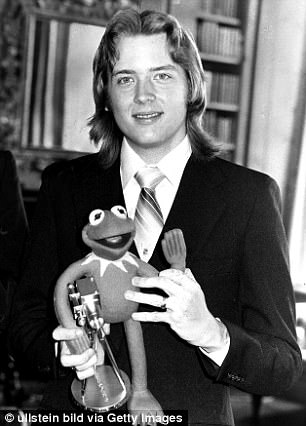 Steve had his own show at a local UHF station in Atlanta, saying his show was two and a half hours a day for 6 months, taking phone calls live with his puppet, Otis. “It was something I’d love to be able to go back and do again,” he said. It was where he learned how to work with a monitor and called it “a bit like going to television puppet school.”
Steve had his own show at a local UHF station in Atlanta, saying his show was two and a half hours a day for 6 months, taking phone calls live with his puppet, Otis. “It was something I’d love to be able to go back and do again,” he said. It was where he learned how to work with a monitor and called it “a bit like going to television puppet school.”
Along with monitor work, he spoke about Muppet performers being particular about eye focus, and other subtleties of Muppet performance. “The character doesn’t move unless it has a reason to. You don’t just have them moving all the time. They’re thinking.” He elaborated, saying some of the difficulty comes, not just from the weight of the puppet, but from keeping it still. That’s when he motioned to Jay Fosgitt’s Bodie Troll puppet, “I don’t know how heavy that is, but he looks big.”
Jay Clark asked how Steve became Kermit. Steve discussed the original 1990 Disney sale and how Jim was healthy at the time, but what he heard was that Jim thought he would be “maybe too busy for Kermit”. Jim was going to become a “big creative guy” at Disney. Steve said Jim was going to practically be what John Lasseter is today (I assume he hasn’t heard the news…).
He briefly discussed some of the other recasts and Ernie, whom he started doing in voice-overs for toys. He made mention that he always assumed he would work on Sesame Street, what with Caroll recommending him for the Muppets, but that he never had the chance to be part of the show until after Jim’s death. The question was asked if there was any big difference performing characters for the Muppets as opposed to Sesame Street. His answer was the same as Frank Oz’s: There is no difference. The Sesame characters are not specifically for kids. Steve then expressed his love for the human cast of Sesame Street, saying that they were like celebrities to him. Of the cast, Steve said, “Sesame Street felt like a real community.”
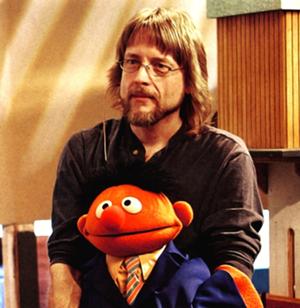 Jay Fosgitt asked Steve about one of his very first puppetry gigs – the Sid and Marty Kroft Indoor Theme Park in Atlanta. He called the experience “very cool,” and said he was hired to perform, not Kroft characters, but his own puppet characters. He reminded the audience that no one would ever allow you to do that today.
Jay Fosgitt asked Steve about one of his very first puppetry gigs – the Sid and Marty Kroft Indoor Theme Park in Atlanta. He called the experience “very cool,” and said he was hired to perform, not Kroft characters, but his own puppet characters. He reminded the audience that no one would ever allow you to do that today.
Jay Fosgitt made mention of how much he admired Steve’s skill as a puppeteer, noting he often tries to emulate his style. He asked who Steve most emulated in his manipulation. Steve said that, while he was often most drawn to Jim’s characters, his style came from learning under five different people and styles – Jim Henson, Frank Oz, Dave Goelz, Richard Hunt, and Jerry Nelson. He was able to pick the most useful from each. Jay mentioned the quote in Of Muppets and Men where either Jim or Frank – he couldn’t recall who – refers to Steve as “the finest puppeteer”. “Who said that???” Steve asked, stunned but pleased. (Note: It was Jim who said “Stevie is a wonderful manipulator of puppets. He has tremendous facility.”)
It was time for the questions. The audience was reminded to stay positive in their questioning, and fortunately they were. And most of the questions were pretty good.
How hard is it performing live versus recorded? Steve said that live was harder, but it’s “my favorite thing to do.” He mentioned that his original UHF show was completely improvised. He then said it was great when they could go on a show like Jimmy Kimmel and they would “let you cut a hole in a $5000 piece of furniture.”
Next he was asked to talk about Fraggle Rock (by a woman with a phenomenal Sprocket puppet). He called it his favorite series, saying that Jim gave them a lot of freedom, and they were all able to grow as performers because of it. He then said, “Wembley was me. An excitable guy who couldn’t make decisions.”
It was then pointed out that Jay Fosgitt was the artist behind the second Fraggle Rock issue of the current series. In response to this, Steve made his Wembley grunting noise (“uh-uh-uh-uh-uh-uh-uh-uhh.”) and said, “I don’t know how you’ll write that into a comic.”
What makes the Muppets work? “Absolute attention to individuality.” He added that the Muppets are strong, deep individuals and an extension of the performers.
The next question was based on Steve’s earlier mentioning that when he was a kid, there were no books by Jim Henson and the Muppets about puppets. The question: Was the book “Muppets Make Puppets” written as a response to this need for kids interested in puppetry? He said he imagined so, and that Cheryl Henson deserved credit for writing it. He then mentioned the documentary, The Muppets on Puppets (from when Frank had a “full head of hair”). He told a story of when he was 10 years old, he would call the PBS programing director for their local station, a man named Jim Scott, and “bugged the daylights out of him” to run The Muppets on Puppets.
What was it like working at PBS with people like Bob Ross and Fred Rogers? This young person wasn’t yet fully aware of how television works, and Steve kindly explained to him that they didn’t cross paths. His scenes with Ernie were often filmed very rapidly within a week or two each year.
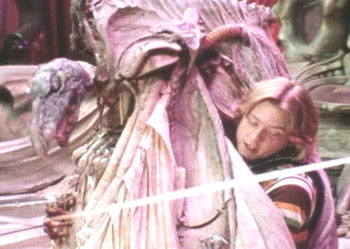 Can you elaborate on the Scientist Skeksis final scene in The Dark Crystal? Steve explained a little about how everything was done. He described the metal harness that helped hold the puppets up as a “torture device” attached to the hips. He then mentioned the numerous people he was dragging around by bicycle cable. Then he talked about the voice, which he called a bad imitation of Peter Lorre (he was shocked when Jim and Frank said they liked the voice). He talked about how painful it was to do the Scientist’s final scream and how Jim, he assumed as part of “Jim’s mischievous Ernie side”, made him redo the scream every time they had to re-dub the film, with multiple takes involved each time.
Can you elaborate on the Scientist Skeksis final scene in The Dark Crystal? Steve explained a little about how everything was done. He described the metal harness that helped hold the puppets up as a “torture device” attached to the hips. He then mentioned the numerous people he was dragging around by bicycle cable. Then he talked about the voice, which he called a bad imitation of Peter Lorre (he was shocked when Jim and Frank said they liked the voice). He talked about how painful it was to do the Scientist’s final scream and how Jim, he assumed as part of “Jim’s mischievous Ernie side”, made him redo the scream every time they had to re-dub the film, with multiple takes involved each time.
This led to a discussion of the similarly voiced Marlon Fraggle, whom Steve described as “the creepiest little weird puppet ever.” He even did a little Marlon for the audience.
 The next questioner commented on Steve’s ability to recreate Kermit and Ernie’s voices – was there anyone you tried to imitate but couldn’t? This is the part you’ve all been waiting for, folks. At long last, a proper discussion of Mr. Poodlepants. Steve said that Mr. Poodlepants started life as a character that Kirk Thatcher would do – an impression of character actor Ed Wynn. But since Kirk couldn’t puppeteer, he gave it to Steve. Steve mentions that he struggled with the character, and even suggested that they should just teach Kirk how to work the puppet.
The next questioner commented on Steve’s ability to recreate Kermit and Ernie’s voices – was there anyone you tried to imitate but couldn’t? This is the part you’ve all been waiting for, folks. At long last, a proper discussion of Mr. Poodlepants. Steve said that Mr. Poodlepants started life as a character that Kirk Thatcher would do – an impression of character actor Ed Wynn. But since Kirk couldn’t puppeteer, he gave it to Steve. Steve mentions that he struggled with the character, and even suggested that they should just teach Kirk how to work the puppet.
Did your family think it weird that you pursued a puppet career? Steve mentioned that he was living at home when he started with the Muppets, but his parents were always supportive… in a cautious way. He recalled a time when he was asked, “What if this puppet thing doesn’t work out?”
Who is your favorite character to perform? He said the most fun was Rizzo, though when he started he didn’t know how to do a New York accent. He recalled being intimidated on The Muppet Show playing what was supposed to be the lead rat next to the more experienced Jerry Nelson and Richard Hunt as secondary rats – but he learned a lot from watching their rats. He then said that while Kermit is mostly nice and pure, Rizzo is just kind of a jerk sometimes.
What is your favorite Muppet song? He mentioned “Rainbow Connection”, “Rubber Duckie”, “Mahna Mahna” – then he mentioned when the Muppets used to do Beatles songs like “Yellow Submarine” and “Octopus’ Garden” on Sesame Street and how he loved those. “I don’t know how they got those. I’m sure they just stole them.”
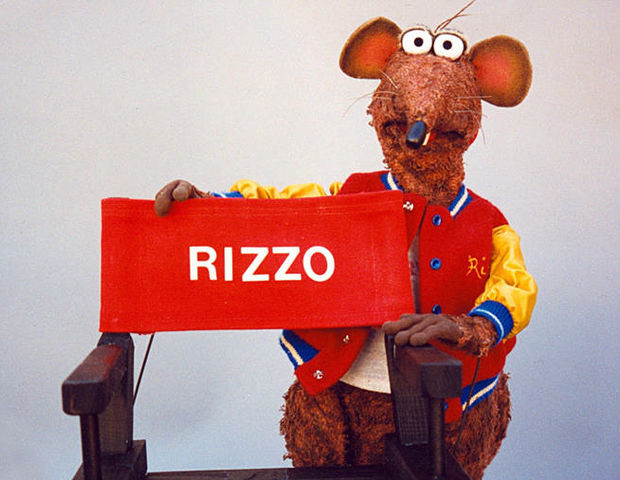 Finally, it was time for the last question, and there wasn’t much time for it: What’s it like working with Frank Oz? He was Miss Piggy and Cookie Monster and Yoda and Fozzie Bear and Grover and… (the questioner mentioned every Frank Oz character he could think of) When he was finally able to answer, Steve called working with Frank “the best thing to ever happen to a Muppet fan.” He finished off saying that he started out as a really big Muppet fan with a lot of preconceived notions about what the Muppets were, but after working with Jim and Frank found that his ideas were “flat wrong,” and that, as a fan, he was given a “more accurate perspective of who the Muppets really are.”
Finally, it was time for the last question, and there wasn’t much time for it: What’s it like working with Frank Oz? He was Miss Piggy and Cookie Monster and Yoda and Fozzie Bear and Grover and… (the questioner mentioned every Frank Oz character he could think of) When he was finally able to answer, Steve called working with Frank “the best thing to ever happen to a Muppet fan.” He finished off saying that he started out as a really big Muppet fan with a lot of preconceived notions about what the Muppets were, but after working with Jim and Frank found that his ideas were “flat wrong,” and that, as a fan, he was given a “more accurate perspective of who the Muppets really are.”
For me, personally, it was a wonderful, Muppety day. It was overwhelming getting to meet two people I’ve admired my whole life. They were both so kind and encouraging to me. If you have the opportunity to see Caroll Spinney on his farewell tour, I highly recommend that you do. And hopefully you’ll get to see Steve Whitmire, who will be making more of these convention appearances. It was a joy to go down this memory lane to Sesame Street with them.
If that wasn’t enough, feel free to watch the full 45-minute panel, which was generously taped and uploaded to YouTube by William Bozarth!
Thanks to Timmah Ganske for the panel photo, to Jay Fosgitt for the Sprocket photo and badge art, to William Bozarth for the video footage, and of course, to Justin Piatt for the writeup and his own incredible artwork!
Click here to discover the secret origin of Mr. Poodlepants on the ToughPigs forum!
by Justin Piatt

